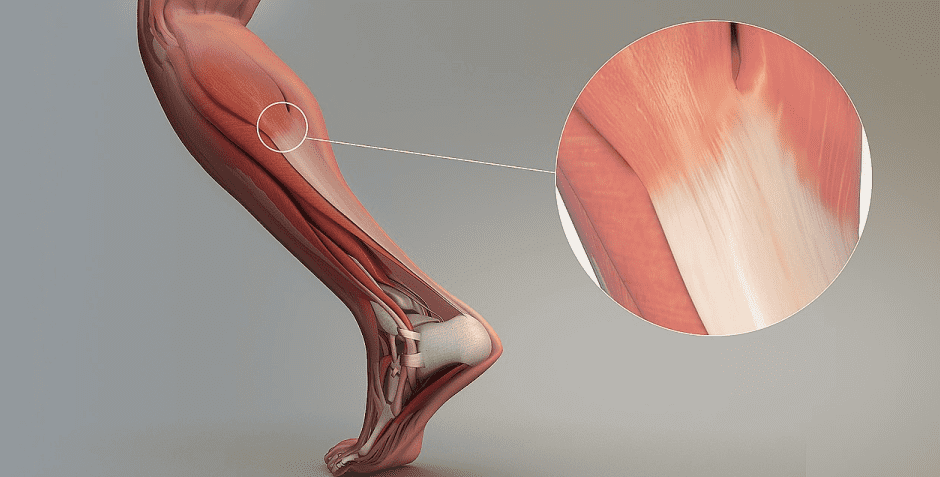Tendons are tough connective tissues that are continuous with muscles, attaching them securely to your bones. When a muscle shortens during contraction, it pulls on its tendon which in turn pulls on its associated bone, producing movement. When subjected to high force loads during exercise, sports or everyday activities, tendons can become injured and inflamed, causing pain and impeding movement.
Although tendons and their associated muscles are found throughout the human body, some are more vulnerable to injury than others. Most tendon injuries occur near joints, including the ankle, knee, hip, shoulder and elbow. While acute tendon injuries do occur, most develop over time as repetitive overuse injuries. Tendons may also become injured due to a fall or a sudden unintentional movement.
Some of the most commonly injured tendons include:
- Achilles tendon at the back of the lower leg near the ankle
- Adductor tendons at the top of the inner thigh near the groin
- Quadriceps tendons where they converge at the knee
- Rotator cuff tendons at the shoulder
- Hamstring tendons at the knee or at the top of the leg
- Tendons of the elbow
- Gluteal tendons at the hip
Due to a lower blood supply and ongoing use, tendon tissue can be slow to heal. Physical therapy offers a number of treatment approaches to accelerate tendon healing and restore normal movement.
The primary symptom of tendon injury is pain, swelling and tenderness near the joint. Other symptoms include:
- Pain that worsens with use
- Increased pain and stiffness at night or upon waking
- Redness, warmth and swelling near the joint
- Crunching sound or sensation when using the tendon
Diagnosis of tendon injuries begins with a health history and physical exam. Your therapist will ask you questions about your physical activities, lifestyle, when your pain began, and other relevant questions. They will palpate the tendon area and do some functional tests for strength and range of motion.
Diagnostic ultrasonography is the most effective imaging method for viewing tendons and their surrounding structures. It enables the clinician to view the tendon in real time, with the patient in motion. Unlike static imaging technologies like Xray and MRI, musculoskeletal ultrasound allows for scanning the entire length of a tendon with the joint in motion, while the patient provides verbal feedback. Because results are instantaneous, treatment can begin immediately.
Despite tendon injuries being fairly common, there is much controversy about the best way to rehabilitate them. While much theoretical research has been conducted, there are very few high-quality clinical trials that show significant improvement from specific treatments.
The main goal of treatment is to improve the ability of the muscle and tendon to manage load. Because muscles and tendons work as a musculotendinous unit, the tendon cannot be treated independently of the muscle. Muscle loading during rehab should consider the nature, speed and magnitude of forces necessary to restore full funcion, particularly when an athlete intends to return to play.
A variety of loading approaches have been used with varying degrees of success. Eccentric loading is fairly popular, where loading is accentuated during the muscle lengthening phase. Isometrics have also been used in combination with concentric and eccentric loading protocols. In isometric exercise, muscle tension is present, but there is no change in joint angle or muscle length.
One study published by the British Journal of Sports Medicine found that isometric exercise reduced pain and promoted healing of the patellar tendon, while eccentric exercises were painful and ineffective. However, it is likely that the effectiveness of different loading methods varies with the tendon location, injury type and the individual patient.
The sports medicine specialists at NYDNRehab are dedicated to eliminating tendon pain and speeding up the healing process. Whether you are a competitive athlete wanting to return to sport or a recreational exerciser who wants to stay active, treating your tendon pain is paramount.
Our integrative and comprehensive examination includes:
- Diagnostic musculoskeletal ultrasonography
- 3D motion analysis with C.A.R.E.N ( computer assisted rehabilitation environment)
- Sonoelastography
- Force plate jumping and load distribution assessment
- KINEO intelligent load assessment
- Surface electromyography
- 3D instrumented gait analysis
- Proteus shoulder assessment
Our treatment options include:
- Tendon-specific physical therapy using groundbreaking technology
- Ultrasound guided injection therapy
- ESWT ( extracorporeal shockwave therapy)
- Individualized rehabilitative exercises
About the Author
Dr. Lev Kalika is clinical director of NYDNRehab, located in Manhattan. Lev Kalika is the author of multiple medical publications and research, and an international expert in the field of rehabilitative sonography, ultrasound guided dry needling and sports medicine Dr. Kalika works with athletes, runners, dancers and mainstream clients to relieve pain, rehabilitate injuries, enhance performance and minimize the risk of injuries. His clinic features some of the most technologically advanced equipment in the world, rarely found in a private clinic.






























































